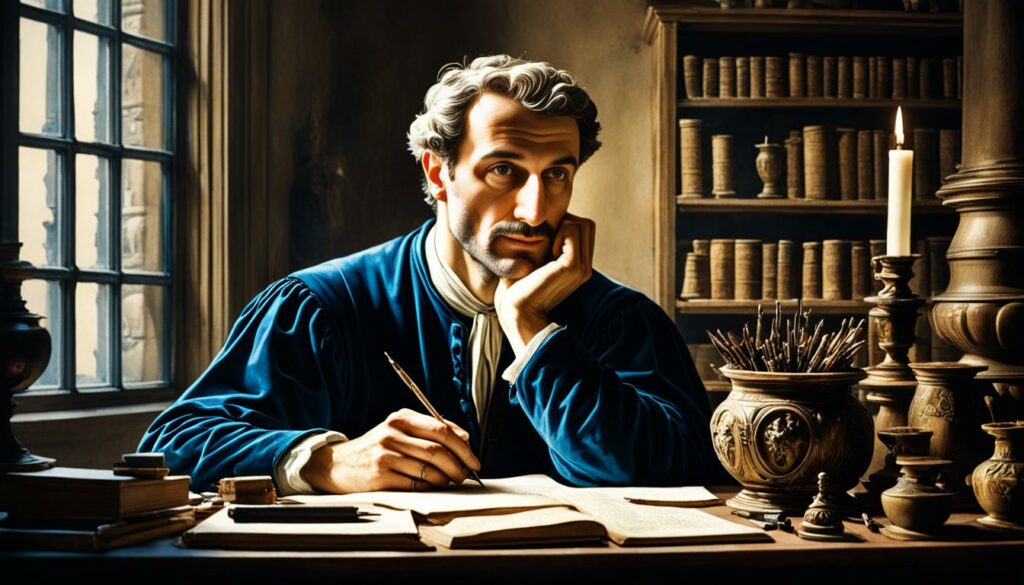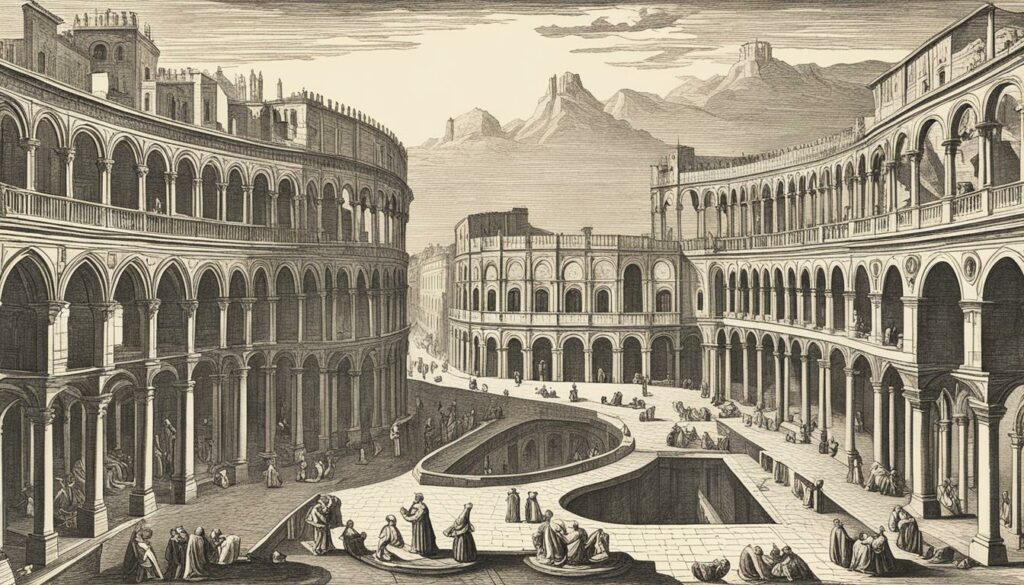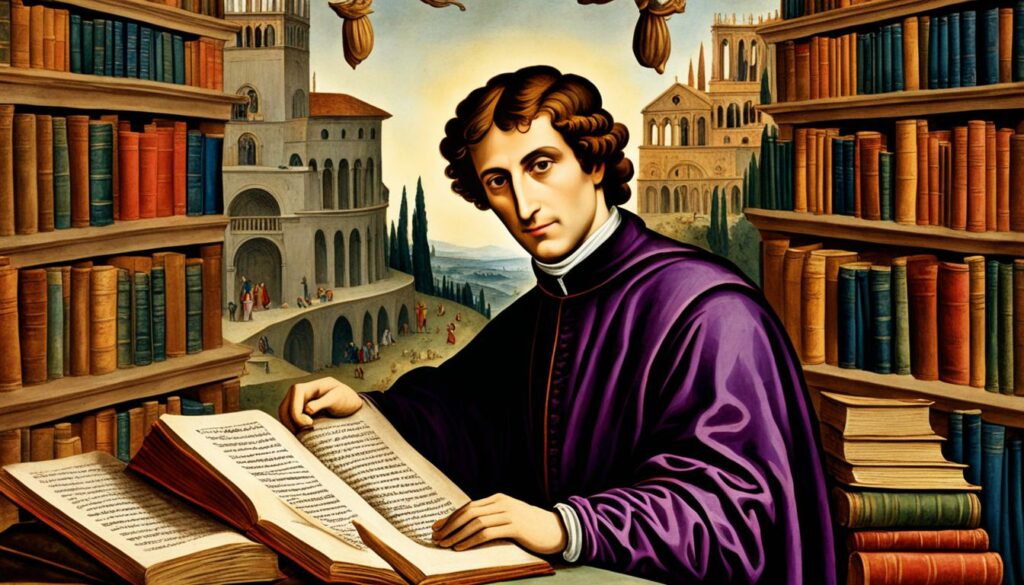Giovanni Boccaccio was a celebrated figure in literature. His work, especially the Decameron, greatly influenced Italian prose, and his contributions deeply shaped the literary world.
Boccaccio was born in 1313 in Certaldo, Italy. He became well-known during the Renaissance, a time of artistic and intellectual growth. As a writer and poet, Boccaccio helped form the era’s literary traditions.
The Decameron is Boccaccio’s most famous piece. It’s a set of one hundred stories that showcase medieval Italian life. He shows his storytelling skill and insight into human nature through these tales.
Boccaccio was more than an author. He played a big role in the rise of Renaissance humanism. This movement focused on classic literature and the humanities. His works reflect a deep understanding of human emotions and experiences.
In this article, we will look into Giovanni Boccaccio’s lasting influence. We’ll explore the Decameron’s origins and themes. Plus, we’ll dive into Boccaccio’s unique way of writing. We aim to show how his literary efforts have shaped Italian prose.

Join us as we explore Giovanni Boccaccio’s incredible legacy. Together, we’ll discover the beauty and impact of Italian prose.
Unraveling the Decameron: A Masterpiece by Giovanni Boccaccio
The Decameron is Giovanni Boccaccio’s famous collection of one hundred tales. It’s a major Italian prose work that shows Boccaccio’s storytelling skills and deeply affects those who read it.
The Origin and Significance of the Decameron
Giovanni Boccaccio wrote the Decameron between 1348 and 1353, after the Black Death. He may have been inspired by the Arabian Nights. This collection is a milestone in storytelling.
The Decameron is important not just for its stories but also for its deep look at human nature and society. It shows life in medieval times from various viewpoints. This gives us insight into the culture and politics of that era.
Themes and Characters in the Decameron
The book touches on themes like love, religion, fate, and class. Boccaccio skillfully blends these themes throughout the stories. This makes the themes stand out and connect with the reader.
It also features a wide range of characters, from noble knights to clever traders. Each character adds something special to the stories. Boccaccio’s deep understanding of people shines through in his work.
Giovanni Boccaccio’s Narrative Style in the Decameron
Boccaccio’s writing style in the Decameron grabs the reader’s attention. He mixes realism, satire, and humor in a unique way. This makes the book engaging and popular.
He uses vivid descriptions and dialogue, bringing the stories to life. This allows readers to dive into the world he has created. Boccaccio’s language is rich and moving.
He also uses different storytelling techniques, like frame narratives, which add layers to his stories and make them complex. These choices show Boccaccio’s talent as a writer.
Peering into the Life of Giovanni Boccaccio: A Fascinating Biography
To really understand Giovanni Boccaccio’s work, we must examine his life’s journey. This bio highlights his upbringing, schooling, and key moments in Florence. We’ll also see how the Black Death deeply affected him and explore his bond with Petrarch.
Giovanni Boccaccio: Early Life and Education
Giovanni Boccaccio was born in 1313 in Paris with an Italian dad and a French mom. But he grew up in Florence, a place his dad called home. His well-off merchant father made sure Giovanni got a good education. Even though he first tried working in business, his love for books eventually won.
As a young man, Boccaccio studied many subjects, including Latin, Greek, philosophy, and classical stories. He also dove into the works of famous writers like Virgil and Ovid. This love for classic literature deeply influenced his future writings.
Giovanni Boccaccio’s Influential Encounters in Florence
In his life, Giovanni met many incredible people in Florence. This city was bustling with cultural and brainy life in the 14th century. He met scholars, artists, and leaders. They all shared thrilling ideas and worked together on projects. These encounters truly opened his mind.
A key figure in his life was the poet Petrarch. Their friendship brought them close, sharing ideas freely. Boccaccio was inspired by Petrarch and others in Florence, shaping his ideas and writing dreams.
The Impact of the Black Death on Giovanni Boccaccio’s Life
The Black Death in the mid-1300s changed Boccaccio’s life and work. This terrible plague killed many and touched everyone in Europe, leading him to write the Decameron, his famous book.
Seeing all the death around him, Boccaccio found comfort in writing. The Decameron tells stories of young folks hiding from the plague. This tough time made him think about life and death in his stories.
Exploring the Relationship between Boccaccio and Petrarch
Boccaccio and Petrarch had a special connection. They loved classic books and new humanistic ideas. Their bond was based on respect and a shared passion for literature.
Even though they were quite different, they kept in touch and respected each other’s work. Boccaccio saw Petrarch as a mentor and often sought his advice. Their relationship marked the Renaissance, inspiring many to explore and create.

The Evolution of Italian Prose through Giovanni Boccaccio
Giovanni Boccaccio was a key Italian writer. He helped shape Italian prose. His work made the Italian language, especially Tuscan vernacular prose, evolve.
Giovanni Boccaccio’s Contribution to Tuscan Vernacular Prose
His famous work, “The Decameron,” is a masterpiece of the Tuscan vernacular. Boccaccio showed the beauty of the Italian language. He widened its use and prepared the ground for future writers.
His stories were full of vivid descriptions and realistic conversations. They captivated readers. Boccaccio’s use of everyday language made Italian literature more accessible to all.
Comparing Boccaccio’s Works with Dante and Other Contemporaries
It is vital to compare Boccaccio with contemporaries like Dante Alighieri. Both significantly impacted Italian literature. Dante’s “Divine Comedy” revealed the potential of the Italian language.
Boccaccio, however, offered stories that felt closer to people’s everyday lives. Analyzing their works, we see how they influenced each other, which greatly enriched Italian prose.
The Influence of Fiammetta on Boccaccio’s Literary Endeavors
Fiammetta, a fictional muse, was crucial in Boccaccio’s writing. She stars in “Elegy of Lady Fiammetta.” Her influence is seen in the rich portrayal of his female characters.
Through characters like Fiammetta, Boccaccio challenged then-current views on women. His narratives explored love, passion, and women’s struggles, adding depth to his writing and Italian prose.

Boccaccio’s impact on Italian prose is undeniable. His work with the Tuscan dialect, comparison with peers, and characters like Fiammetta changed literature. His legacy inspires writers today, showing the powerful role of storytelling.
Legacy and Impact: Boccaccio’s Enduring Influence in Literature
Giovanni Boccaccio changed Italian prose and literature forever. His stories still captivate us, showing their timelessness. He was a master at creating stories and exploring emotions.
The Decameron Web keeps Boccaccio’s works alive. It’s a great online archive. It offers his writings and much-needed context for readers and scholars.
Many Italian writers and poets drew inspiration from Boccaccio. His storytelling and characters were revolutionary. Famous writers like Petrarch and Dante were influenced by him, which shows his lasting effect.
Boccaccio also advanced prose writing. He skillfully used the Italian language in new ways. This set new standards and helped shape the Italian language. His work in prose inspires writers even today.

